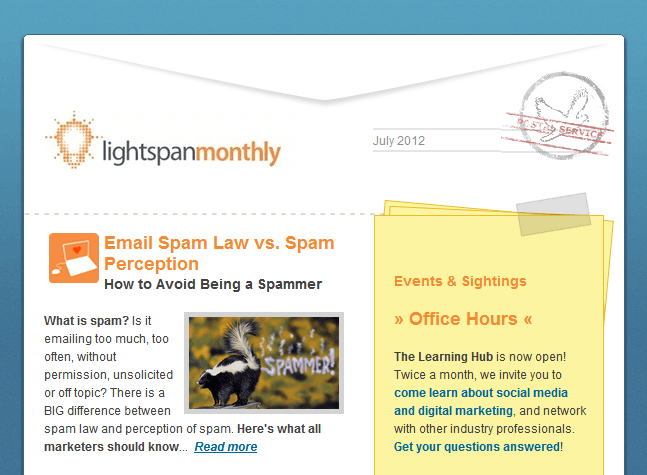 Two truths: Email marketing is an effective, inexpensive form of advertising. And it can be really annoying, earning you the moniker of “spammer.”
Two truths: Email marketing is an effective, inexpensive form of advertising. And it can be really annoying, earning you the moniker of “spammer.”
So how do you reconcile the two? Email marketing has returned some of the highest ROI numbers for several years now: $40.56 per dollar spent in 2011, according to the Direct Marketing Association. Usually only Google Adwords performs any better. What sets these apart? The “perfect” email is a blend of:
- bite-sized content (think Letterman’s top 10 lists)
- a subject line that makes them want to open it (Hint: Don’t lead with “My awesome newsletter”)
- the ability to be opened and readable in any email browser, even without graphics
- an email list who has expressed interest in receiving your email
Yet we’ve all received (and unsubscribed from) usually well-intentioned emails that have all of these elements. What will set you apart?
Standing Out From the Crowd
One of the most overlooked areas is design. There are so many readymade templates out there, but ask yourself: Is my important information communicated in the preview pane of an email browser? How about mobile: Is it too complicated to be seen easily on an Android or iPhone? Most people are picking up email first on their mobile device these days, followed by desktops and even tablets later. And does your template reflect your brand, or is it still, well, just a template that could be used for the dog walking service down the street?
These pesky metrics, and using them to your advantage, is what really drives a great email. For the sheer amount of data, an updated email list is the key to everything. I’m sometimes surprised by those who unsubscribe from my emails, but I’ve reconciled it with the fact I’m not wasting my time on uninterested folks. And those who are interested are triggered to make contact today. I’d rather spend time with those who get me: the many others who are into my content, my knowledge, and, well, me. It’s some of the best sales data I could ever ask for.
Even the unthinkable, such as confirming subscribers’ interest, creates a stronger database. Theresa Carter of The Local Tourist found that after asking subscribers to confirm their interest in receiving her newsletter, her open rate has gone from 14% to 58%, the response to calls to action has increased, and her new subscriber rate has quadrupled. What’s better than a few thousand followers? A few thousand new ones who are involved, and happily so.
That one email is not the end of the road either: Segment your list into donors, volunteers, staff and board members, or for current customers, past ones, prospects, and those who seem on the verge. Each is an opportunity to personalize the experience, connect more deeply and amp up the customer service experience. Share across your social networks for even more channels.
Optimizing for Results
Email, like any online media, is ever-changing, and you too have to change to stay relevant. Modify your email design and subject line until they’re performing optimally. Weed your list as you would a garden. Share useful information without overwhelming your reader (or yourself). Watch the metrics, and realize the relationships and results from your own brand of well-crafted spam.
With over 15 years of print, web and multimedia experience, Lisa Ghisolf is well acquainted with the design, new media and printing industries as well as advanced topics in SEO and user interface design. She began Gizmo Design, Inc. in 2003 and has conceptualized and produced jobs for large and small companies alike, with the understanding that design is a collaborative process and the online space needs clear communication to be successful. Follow @gizmodesign or connect on Google+.

Leave a Reply